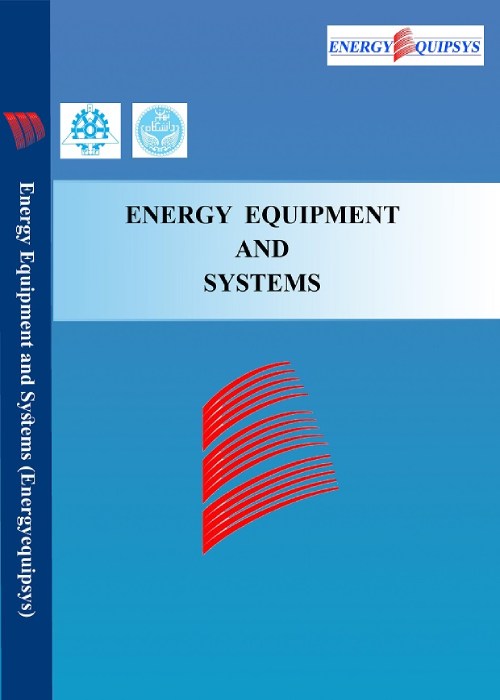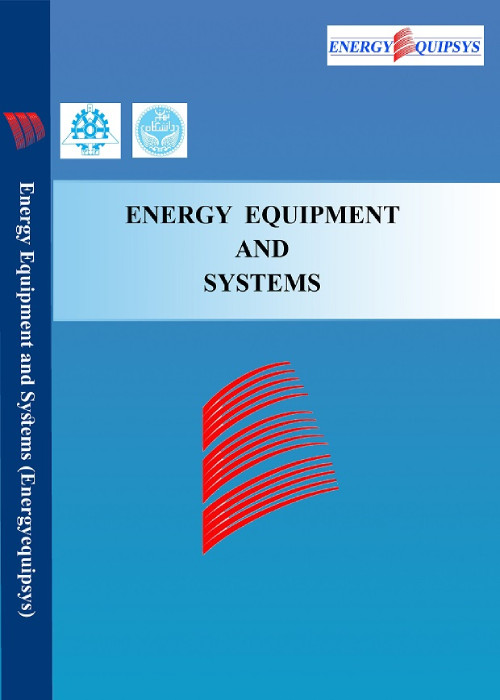فهرست مطالب

Energy Equipment and Systems
Volume:11 Issue: 3, Summer 2023
- تاریخ انتشار: 1402/06/10
- تعداد عناوین: 6
-
-
Pages 261-275In this study, thermodynamic analysis for integration of a PEMFC with an organic Rankin cycle, and an ejector expansion vapor compression refrigeration system is presented. The input energy of the system is supplied by the waste heat of a PEMFC. Energy and exergy analysis is performed on each system component and compared with a simple ORC-VCR without an ejector. The results show that employing the ejector can improve the refrigeration capacity, energy efficiency, and exergy efficiency by 18.88%, 12.29 %, and 12.27%, respectively, compared to a simple ORC-VCR system. Moreover, the overall energy and exergy efficiency of the system is 33.43% and 5.46% higher than a standalone PEM fuel cell. Furthermore, in the parametric study, the effect of condenser temperature, evaporator temperature, ejector efficiency, PEMFC operating temperature, current density, and PEMFC operating pressure on the energy efficiency, exergy efficiency, and refrigeration capacity of the system is investigated.
-
Pages 277-304Solar power plants have received much attention in recent years due to the use of renewable energy sources, no production of polluting gases, high concentration ratio, and proper thermal efficiency. But solar radiation absence at night prevents the uniform and continuous production of electricity. Also, the challenge of the ever-increasing accumulation of municipal waste has caused the waste fuel-based power plants to attract the attention of many industrialized and developing countries. In the present research, practical solution is proposed to solve the challenge of not producing electricity in solar tower power plants during the night by using waste as the input fuel of the power plant. The results obtained from the case study of the investigated cogeneration system show that the electric powers produced by the subsystems of the air Brayton cycle, the reheat Rankine cycle, and the organic Rankine cycle are equal to 4502.6 KW, 2640.3 KW, and 118 KW, respectively. The central receiver of the solar tower has the highest rate of irreversibility, accounting for 34% of the total exergy destruction rate. Based on the parametric study results, the irreversibility of the entire cogeneration system has a direct relationship with the inlet temperature to the turbine. Increasing the moisture of the waste also leads to a decrease in the temperature and percentage of syngas produced, and causes a decrease in the overall performance of the system.The net power of the cogeneration system increases first and then decreases with the increase in the temperature of the gasification process.Keywords: Sustainable energy system, Solar tower, Gasification, thermodynamic analysis, Cogeneration System
-
Pages 305-319
Noise pollution is a significant challenge in developing the use of wind turbines, especially in residential areas. H-Darrieus turbine is a wind turbine widely used in residential areas, usually exposed to variable wind speeds, and works in a wide range of tip speed ratios. In this article, the importance of tip speed ratio on the output power and noise pollution of an H-Darrieus turbine is numerically investigated using the SST-kω model (for flow simulation at tip speed ratios of 2.04 to 3.3) and the Ffowcs Williams-Hawkings equations (for noise calculation in far-field). The directivity results show that the angle position of maximum noise differs for different tip speed ratios. Therefore, noise calculation only at the angle position of 0o, widely used for wind turbines, is insufficient. The results show that in terms of noise pollution, tip speed ratios of 2.04 and 3.3 have the best and worst performances, with maximum noises of 67.91 dB and 71.85 dB, respectively. On the other hand, the tip speed ratio of 2.64 has the highest power (2.92 times the power of 2.04) with a maximum noise of 68.26 dB, which is negligibly higher than that for the tip speed ratio of 2.04. Overall, it is concluded that in terms of compromise between noise pollution and power generation, the tip speed ratio of 2.64 is the best point for this turbine.
Keywords: Aerodynamics, CFD, Darrieus turbine, noise pollution, Vertical-axis wind turbine -
Pages 321-337In the context of the industrial grinding process, the quality of products is often assessed by the final surface roughness, which is influenced by various parameters in the industrial environment. Previous studies lacked a feasible formulation based on a kinematical and statistical model to explain the uncertainty and non-linearity of grinding conditions, particularly concerning the cooling method, leading to significant discrepancies between the formulated and real results. This study introduces a novel strategy that combines deep learning and optimization to establish a suitable framework. It employs an artificial neural network to simulate and predict surface roughness, considering various dressing and cooling parameters in the industrial grinding of St37 steel alloy. Initially, an analysis of variance (ANOVA) is conducted to determine the correlation between input and output data. Subsequently, a neural network approach with one and two hidden layers, incorporating various activation functions, is employed. Therefore controlling and improving the accuracy of surface roughness predictions in industrial grinding processes can be automated. The mean squared error (MSE) metric is applied to each implementation to identify the best network architecture for the dataset. Upon selecting the network with the lowest MSE, the final algorithm predicts a set of randomly selected data from the dataset, achieving an overall accuracy of 80%. When compared to the accuracy of the formulated implementation, the neural network approach demonstrates a significantly higher accuracy of up to 30%, surpassing conventional analytical formulation in predicting final surface roughness. These results underscore the considerable potential and feasibility of deep learning approaches for industrial applications.Keywords: Artificial neural networks, Grinding, Surface Roughness Control, Dressing, Sustainable Machining
-
Pages 339-351Iron furnace gases, a byproduct of the steel and iron industries, have been the subject of research on employing them to power some of the factory's internal needs. The rise in fuel costs and focus on energy system sustainability have created distinct frameworks for heat loss sources and low-value fuels. In this study, iron furnace gas produced in steel and iron factories has been used to produce additional power to provide part of the domestic power consumption of these factories. Supercritical carbon dioxide cycle has been used to generate power. The results show that at the optimal point, the system has emissions of 0.52 and a net power output of 22100 kWh. Also, the efficiency of the system is 38.56% and the emission of carbon dioxide is 0.510 ton/MWh. Also, by increasing the temperature of the exhaust gas by 150 degrees, it is clear that 2 MW of recycled heat can be obtained. Also, in this regard, the output work of the turbine has increased by 0.8 kW and increases the efficiency of the whole cycle by 31.5% to 37%.Keywords: Supercritical carbon dioxide cycle, Steel plant, blast furnace, Multi-effect desalination unit
-
Pages 353-369This study aims to develop, and examine a cogeneration system for electric power, hydrogen, and ammonia production. A modified Rankine cycle is configured to supply power. An electrolyze unit and an ammonia synthesis reactor are used to provide hydrogen and ammonia. The system is investigated from technical and economic aspects. The inquiry outcomes disclose that the reaction pressure and hydrogen to nitrogen molar ratio have mainly affected the ammonia production rate increment. The system energy and exergy efficiencies as well as the total unit cost of the product are at about 50.47 %, 51.41 %, and 638.3 $/GJ, respectively. The results show that the exergy destruction rate of the system is 89.797 MW. Moreover, 6.438 kg/h of hydrogen and 6.528 kg/s of ammonia are attainable. The sweeping sensitivity investigation on the economic aspect reveals that the reaction pressure, input hydrogen molar ratio, and hydrogen to nitrogen molar ratio have a positive effect on the sum unit cost of the product's decrement. Finally, the thermodynamic sensitivity examination outcomes affirm that altering reaction temperature leads to technical inefficiencies of the proposed cogeneration system.Keywords: Exergoeconomic Analysis, Hydrogen, thermodynamic analysis, Ammonia, Cogeneration Plant, Exergy Efficiency


